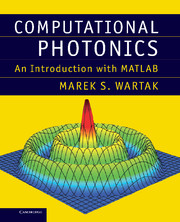Book contents
- Frontmatter
- Contents
- Preface
- 1 Introduction
- 2 Basic facts about optics
- 3 Basic facts from electromagnetism
- 4 Slab waveguides
- 5 Linear optical fibre and signal degradation
- 6 Propagation of linear pulses
- 7 Optical sources
- 8 Optical amplifiers and EDFA
- 9 Semiconductor optical amplifiers (SOA)
- 10 Optical receivers
- 11 Finite difference time domain (FDTD) formulation
- 12 Beam propagation method (BPM)
- 13 Some wavelength division multiplexing (WDM) devices
- 14 Optical link
- 15 Optical solitons
- 16 Solar cells
- 17 Metamaterials
- Appendix A Basic MATLAB
- Appendix B Summary of basic numerical methods
- Index
10 - Optical receivers
Published online by Cambridge University Press: 05 July 2013
- Frontmatter
- Contents
- Preface
- 1 Introduction
- 2 Basic facts about optics
- 3 Basic facts from electromagnetism
- 4 Slab waveguides
- 5 Linear optical fibre and signal degradation
- 6 Propagation of linear pulses
- 7 Optical sources
- 8 Optical amplifiers and EDFA
- 9 Semiconductor optical amplifiers (SOA)
- 10 Optical receivers
- 11 Finite difference time domain (FDTD) formulation
- 12 Beam propagation method (BPM)
- 13 Some wavelength division multiplexing (WDM) devices
- 14 Optical link
- 15 Optical solitons
- 16 Solar cells
- 17 Metamaterials
- Appendix A Basic MATLAB
- Appendix B Summary of basic numerical methods
- Index
Summary
In this chapter we summarize the operation of an optical receiver, which is an important part of an optical communication system. An overview of design principles for receivers used in optical communication systems is provided by Alexander [1]. The aim of a receiver is the recovery of the transmitted data. The process involves two steps [2]:
the recovery of the bit clock,
the recovery of the transmitted bit within each bit interval.
A block diagram of an optical receiver is shown in Fig. 10.1 [3], [4].
The receiver consists of a photodetector which converts the optical signal into electrical current. A good light detector should generate a large photocurrent at a given incident light power. They should also respond fast to the input changes and add minimal noise to the output signal. This last requirement is of crucial importance since the received signal is typically very weak. In digital optical communication systems the detection process is often conducted with a PIN photodiode.
There are generally two types of detection [4]: direct detection (also called incoherent detection) and coherent detection.
Direct detection detects only the intensity of the incident light. It is used mainly for intensity or amplitude modulation schemes. It can only detect an amplitude modulated (AM) signal.
Coherent detection can detect both the power and phase of the incident light. It is therefore used when phase modulation (PM) or frequency modulation (FM) is preferred. Coherent detection is also important in applications such as WDM.
- Type
- Chapter
- Information
- Computational PhotonicsAn Introduction with MATLAB, pp. 240 - 261Publisher: Cambridge University PressPrint publication year: 2013



